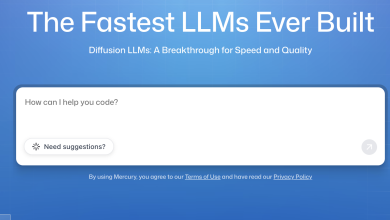
Velangani Divya Vardhan Kumar Bandi has spent the past seven years solving the kind of problems that make AI practical rather than theoretical. As the Founder & CEO, NB Alpha Omega LLC and founder of multiple ventures, he has built machine learning systems across some of the most regulated industries in tech, including healthcare at CVS Health and Ascension Health finance at SoFi, and cloud infrastructure spanning GCP, AWS, Azure, and Databricks.
His work focuses on a particular challenge: taking AI models from development notebooks to production systems that handle real data, real users, and real regulatory requirements. He holds dual Google Cloud certifications as both a Professional Data Engineer and an ML Engineer, providing him with insight into how infrastructure and intelligence must work together.
Beyond his technical roles, Vardhan runs NB Alpha Omega LLC for IT consulting and staffing, founded Vastraa Veda as a premium ethnic wear brand, and invests in real estate and food and beverage ventures. He’s pursuing an MBA at Dallas Baptist University while exploring doctoral research in management science and digital transformation. He mentors emerging data professionals and carefully considers how AI impacts business models across various industries.
In this conversation, Vardhan discusses what makes AI projects succeed or fail in production, how multi-cloud expertise influences system design, why vendor-agnostic thinking is essential, and what he has learned from building businesses while working on AI at scale.
- You’ve spent over seven years building AI and ML solutions across healthcare, finance, and cloud platforms. Can you describe a specific project where the AI system you developed created measurable results for the business?
One of the great projects that I have worked on was the development of an AI-driven predictive platform to enhance cardiac ablation decision-making. Cardiac ablation is a procedure used to treat arrhythmias, where the treatment is costly and the efficiency ratio is very low. We have tried and worked to solve this problem by architecting an AI/ML pipeline that basically takes three categories of data 1. Patient lifestyle and behavioral habits such as smoking, exercise and dietary routines 2. Family and genetic indicators for cardiovascular diseases and 3. Detailed clinical data including ECG signals, echocardiograms and prior cardiac intervention records which are obtained using wearables. We have basically used Google Cloud BigBuery, Dataflow and Vertex AI, we engineered features at scale and trained models leveraging methods such as XGBoost along with AutoML for rapid experimentation and explainable AI to ensure transparency in predictions. We were able to deploy the solution through a secure API, embedding it directly into physician workflows so that cardiologists could view predictive insights during patient consultations. This development has reduced unnecessary ablation procedures. We were also able to identify which of the major factors contributed to prediction rather than using the limitation of AI of black box.
- You hold certifications as both a Google Cloud Professional Data Engineer and ML Engineer. How has the relationship between data infrastructure and machine learning changed since you started working in this field?
From the start of my career, I have always been very passionate and curious about working with Data and its infrastructure. When I first started working, data infrastructure and machine learning were two different worlds. Coming to data engineering, it mainly focuses on building ETL/ELT pipelines, data cleaning and data movement to data warehouses/lakes where machine learning primarily works on smaller test and train datasets to develop models. This difference used to cause a lot of chaos and inconsistencies and create challenges. Over the years, the relationship has completely evolved into what we can call a deep convergence of data and AI pipelines. Especially with the use of cloud platforms like GCP, AWS, we were able to design end-to-end lifecycles without separating data engineering and Machine learning. For example using streaming tools like Pub/Sub, or Dataflow, or Kafka we can continuously feed real time data to build real-times features using ML models. Another key development across industries is automation, in the past deploying models required manual handoffs and custom code, but today we have CI/CD pipelines that automate everything from feature engineering to training, deployment and monitoring. The data infrastructure has grown to a large extent by supporting key aspects like data governance, data lineage. Data engineering has become the core foundation of machine learning and ML is no longer about algorithms but about delivering high quality, reliable and timely data into models.
- You’ve deployed solutions across GCP, AWS, Azure, and Databricks. What factors do you consider when selecting a platform for a particular AI problem, and what missteps have you observed companies make during this process?
Whenever we have to select a cloud platform, I typically take three major factors into consideration: features integration, cost efficiency.
When it comes to features, undoubtedly GCP stands out for its AI/ML services such as Vertex AI, BigQuery ML and built in MLOps frameworks which helps to build and fail fast with very minimal deployment time, where AWS is nonetheless offers deep customization through services like SageMaker, Glue and Redshift. Azure on the other hand has strong enterprise alignment with tools like Synapse and Fabric.
For integration, it is very important to make sure the platform completely aligns with the existing data ecosystem since it doesn’t make sense where a warehouse is hosted in Azure and if we use GCP for building machine learning models.
Lastly, cost is a hidden trap as sometimes companies choose a platform based on vendor relationship or purely on hype without even evaluating the long-term total cost of ownership. I would definitely choose the platform by listing the pros and cons of these three metrics.
- Your career has taken you from engineering roles at CVS Health and SoFi to founding NB Alpha Omega LLC. What insights about deploying AI in enterprise settings did you gain once you started your own company that you hadn’t recognized while working within larger organizations?
When I was working at large tech companies like CVS Health and SoFi, I gained deep technical expertise in building scalable pipelines, deploying AI models, and operating within highly regulated, large-scale environments. The focus was completely on technical rigor, compliance, and integration with existing enterprise ecosystems, and I often had the advantage of mature infrastructure, budgets, and specialized teams. However, once I started NB Alpha Omega LLC, in a consulting and entrepreneurial role, I saw how critical it is to design AI solutions that directly tie into ROI, cost reduction, and time-to-value, because in my company we won’t have large investments without clear measurable outcomes. I also recognized that many enterprises struggle with change management, cultural adoption, and trust in AI, not just the technical hurdles. At big firms ,where data and budgets are huge, smaller organizations often require solutions that are low cost, and lean, sometimes delivering incremental automation with tools like GCP Vertex AI before scaling into full enterprise AI is not a correct strategy. The most valuable insight I gained as a founder is that AI success is not only about technical accuracy, but about aligning people, processes, and costs with the solution, ensuring adoption across business users, IT, and leadership. This perspective has aided how I now build solutions that are technically sound, business-relevant, and financially sustainable. We are trying to build an automated IT portal by completely prioritizing the cost.
- You’ve seen both successful AI deployments and failed ones. What separates the projects that make it to production and generate value from those that remain stuck in development?
The main and biggest difference between AI projects that succeed and the ones that fail is the balance between the technology and business.
Successful deployments has had a clear definition of the business problem, measurable KPI’s and strong stakeholder so as discussed above the AI solution is directly tied to ROI, efficiency and cost reduction. For the AI application to give the desired results we must make sure that we prioritize data quality, data governance and a proper infrastructure which helps to build accurate models without any bias and discrimination as these are one of the top problems with AI.
In general, when I have seen a deployment fail, I’ve seen a significant concentration put on developing a perfect model without giving enough importance to data, optimization techniques or cost effectiveness. I have also seen scenarios where AI developments fail when the model is not clearly understood.
- You’re pursuing doctoral research in management science and digital transformation while running multiple businesses. How is AI reshaping organizational structures and business models beyond just technical operations?
I am currently pursuing my MBA and actively exploring doctoral research opportunities in the future. I have observed while running multiple businesses and consulting for enterprise that AI is fundamentally reshaping organizations beyond technical capabilities. Initially AI was only seen as a tool for automation but now it has taken a complete shift by involving in business models and decision-making hierarchies. It’s also restructuring the business models as many companies are moving away from one-time product sales toward AI-driven services and subscription models by giving utmost priority to the data. At the same time, it is also kind of scary as AI raises questions around governance, ethics and collaboration. Currently AI is no longer only about efficiency but it has involved in decision making, organizational transformations and redesigning company structures.
- Your ventures span IT consulting, fashion retail with Vastraa Veda, and real estate investing. Have you noticed common patterns in how AI creates value across these different sectors?
Across three different industries, one of the common patterns I’ve seen is that AI definitely creates value when it is used to turn raw data into actionable decisions that directly create impact on revenue, cost and customer experience. In IT consulting, AI improves efficiency by automating routine processes like resume screening, offer letter generation and project matching which reduces repetitive tasks for humans and also reduces operational costs. When it comes to the fashion industry, AI is ruling with personalization and demand forecasting. The best example is analyzing customer behavior to recommend dresses that fit seasonal trends or suitable clothes while browsing. Lastly,in real estate, AI has added so much value by predictive analytics, whether forecasting property value or analyzing neighbourhood and growth.
- You’ve emphasized mentoring the next generation of AI professionals. What capabilities do you think current AI education tends to overlook or underemphasize?
Current AI education often does a good job except overlooking three major critical areas: data literacy, business alignment, and ethics.
Looking first at data literacy, technologists are majorly focused on developing and deploying models but are not quite focused on considering the quality of data. A simple outlier can cause huge disruption in the way the reports are generated, they need to be trained to feed almost near to perfect data to obtain desirable results.
Secondly, thinking of the hype, everyone wants to incorporate AI without even evaluating if their business would really need it and how well AI could leverage and scale up the growth especially in terms of generating profits or reducing operational costs.
Thirdly, understanding bias is a very important aspect and is one of the current limitations in AI. This can only be solved with the quality of data and correct technical requirements. When mentoring, I mainly encourage aspiring AI professionals to view themselves not just as model builders but especially as problem solvers who can bridge technology, business and people because those highlights will make them stand out with other competitors.
- Foundation models, AutoML, and increasingly accessible tools are changing how AI systems get built. How do you expect the role of AI engineers and data scientists to shift over the next several years?
With the rise of foundation models like AutoML, and low-code/no-code AI platforms is obviously changing the path but i can clearly say it cannot replace AI engineers but can upscale their value in the chain. Previously it was focused on building models, tuning hyperparameters and automation but in future it will be more on solving real world problems, integrating to business to solve or reduce costs, designing ethical systems. AI engineers will majorly focus on deriving the enterprise level solutions using the large data and existing models to solve real world problems and data scientists to strengthen domain knowledge and communication so that they can influence AI to derive better results rather than just training or developing models.
- From your experience working across multiple domains and building businesses around AI, what problem or opportunity in the field deserves more attention than it currently receives?
From my experience working across industries and building businesses around AI, one area that deserves far more attention is the gap between AI innovation and real-world adoption. There is a lot of focus on building sophisticated models and chasing cutting-edge accuracy, but not enough on solving the everyday challenges that block organizations from actually using AI effectively, things like poor data quality, lack of trust in outputs, integration with legacy systems, and change management. Another overlooked opportunity is AI accessibility for small and mid-sized businesses. Large enterprises can afford big data teams and infrastructure, but smaller firms, which make up the majority of the economy, often get left out even though AI could create enormous efficiency gains for them. I also believe responsible and explainable AI is still under-emphasized; too many solutions are treated as black boxes, which slows down adoption in sensitive areas like healthcare and finance. In short, while the hype tends to focus on new algorithms or foundation models, the bigger opportunity is building AI that is trustworthy, affordable, and easy to integrate, so that it delivers measurable value to businesses of all sizes.




